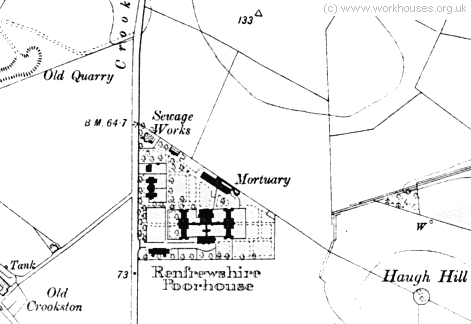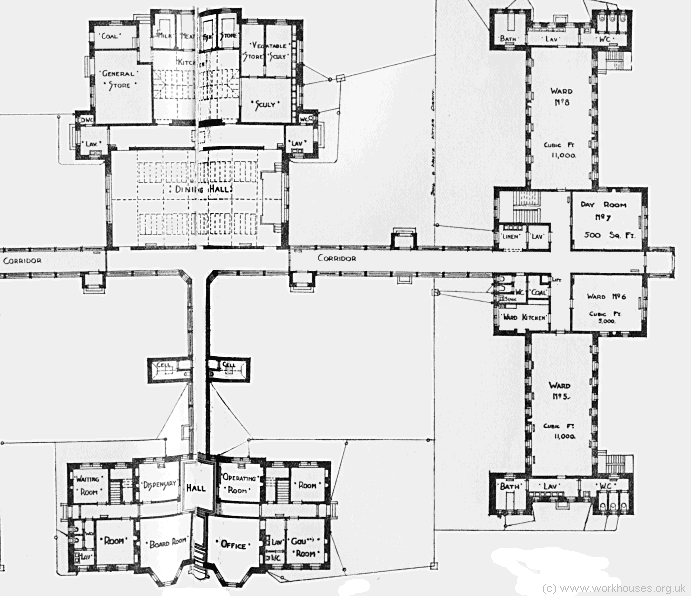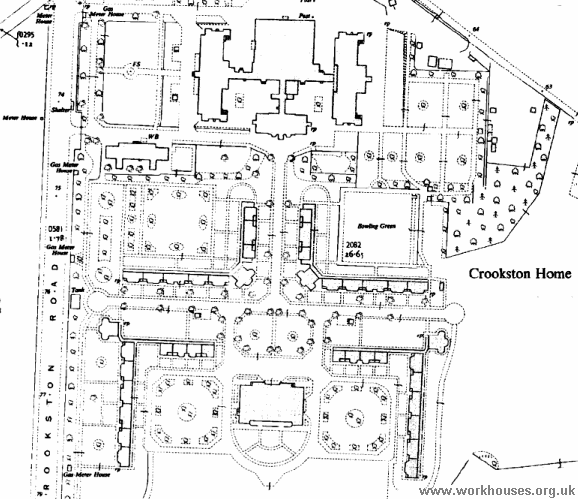Renfrewshire Combination, Renfrewshire
Renfrewshire Combination was formed in 1901 as a successor to the short-lived Busby Combination. The Renfrewshire Combination comprised the parishes of: Carmunnock, Cathcart, Eaglesham, Eastwood, Erskine, Houston, Inchinnan, Kilbarchan, Kilmalcolm, Lochwinnoch, Mearns, Neilston, Renfrew, and Rutherglen.
A Combination poorhouse was opened in 1906 on a nine-acre site at Rosshall, about five miles to the south-west of Glasgow. The buildings, which accommodated 428 inmates, were designed by Messrs Macwhannell and Rogerson of Glasgow. The establishment comprised an administrative block, kitchen and offices, ward blocks, a probationary block, children's block, workshops, boiler house, laundry, mortuary, and piggery. The total cost of the buildings was just over £55,000 plus £2,500 for the site and £1,125 for furnishings. The site layout is shown on the 1916 map below.

Renfrewshire Combination poorhouse site, 1916.
The buildings adopted the popular pavilion-plan layout. A central administrative block contained three-storey section at the south contained a board room, offices, clothing store, matron's room, and dispensary on the ground floor; governor's quarters and nurses' accommodation on the first floor; and servants' quarters on the second floor. This connected through to a single-storey portion at the north where the dining-hall, kitchen and stores were located. A central corridor connected the central block to three-storey ward blocks at each side with male wards were placed at the east and female at the west. Each ward block floor comprised two large 18-bed wards either side of a central area containing a kitchen, stores etc. and either a third large ward, or small ward plus day room. Aged and infirm inmates were placed on the ground floor, sick inmates on the first floor, and 'turnouts' on the second floor. The ground floor plan showing the administrative and male ward blocks is shown below.

Renfrewshire Combination poorhouse plan.
During the First World War, the poorhouse was placed entirely at the disposal of the military authorities.
The poorhouse later became known as the Crookston Home Poor Law Institution and in 1946 had 300 beds.
In the mid-1930s, the area to the south of the poorhouse was developed as a cottage homes site for the elderly. The architect of the scheme was W Barrie.

Crookston Home site, c.1950.
The former poorhouse buildings no longer exist and the site has been redeveloped as a housing estate.
In addition to its membership of the Combination, the parish of Eastwood also operated its own parochial lodging house. It was located at 8 Herriet Street, Pollokshields, and in 1881 had fifteen pauper boarders in residence.
Records
Note: many repositories impose a closure period of up to 100 years for records identifying individuals. Before travelling a long distance, always check that the records you want to consult will be available.
- Glasgow City Archives, The Mitchell Library, 210 North Street, Glasgow G3 7DN, Scotland. Holdings: minute books (1901-26).
Bibliography
- None.
Links
- None.
Unless otherwise indicated, this page () is copyright Peter Higginbotham. Contents may not be reproduced without permission.


